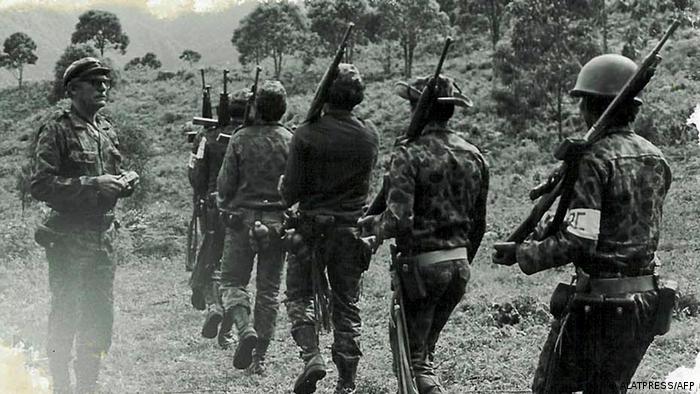QCOLOMBIA – In September 2016, the Colombian government signed a peace deal with the rebel group FARC. A look at the guerrillas who started out as leftist idealists and ended up as hostage-takers, racketeers and mass murderers.
From ragged rebellion to military might
In the mid-20th century, Colombia saw a raging battle between different political camps. Left-wing rebel groups founded independent republics in remote areas, which were gradually taken over by government forces. Two of the leaders of the “Republica de Marquetalia” escaped, however. In 1966, Manuel Marulanda and Jacobo Arenas (left) founded the Revolutionary Armed Forces of Colombia or FARC.
A life dedicated to armed struggle
In the inaccessible Amazon region, farmers who knew the land well were tactically superior to the more cumbersome Colombian army. The FARC picked up strategies from other guerrilla groups in Latin America and began recruiting students and slum dwellers from the cities. That allegedly included more than 18,000 minors. Women, too, joined in. However, they were strictly forbidden to have children.
Mercenaries, drug traffickers, racketeers
To fund themselves, the guerrillas entered the drug trade. They moonlighted as mercenaries for the cocaine cartels and later participated in cultivation. Though the Colombian army, with the help of the US, destroyed plantations and drug labs (photo), the rebels raked in plenty of cash. At times, the rebels controlled an area as large as Switzerland. They also levied a “revolutionary tax” there.
Kidnappings as a lucrative business model
The FARC is estimated to have earned hundreds of millions of US dollars each year. Part of the reason was another flourishing business model – the rebel group is believed to have been behind nearly 10,000 kidnappings from 1970 to 2010. The most prominent victim was presidential candidate Ingrid Betancourt in 2002. It took six years for the Colombian army to free Betancourt and 14 other hostages.
The struggle for peace
As early as the 1980s, the FARC negotiated an initial, fragile cease-fire with the Colombian government. Some members tried to help to shape policies in political parties. In the 1990s, they presented a 10-point political program. In 2001, FARC leader Manuel Marulanda (right) met with President Andres Pastrana (left) for renewed peace talks. But success proved elusive.
Continuing terror campaign
The FARC and the Colombian government were unable to reach a deal in part because the rebels widened their campaign of terror during the talks. They attacked military posts and police stations with explosive devices and raids. They showed no consideration for civilian victims — as seen here in Medellín in 2003, when a car bomb injured 30 people and killed six, including a small child.
Left and right-wing terror
Till today, it remains unclear who was behind the massacre of 119 civilians in this church in May 2002. In addition to the FARC, suspicions have centered on right-wing paramilitary groups. Most of the approximately 250,000 people killed in the ongoing conflict were civilians caught between the fronts or murdered as political opponents, suspected collaborators or family members of opponents.
A weakened guerrilla group
Colombian President Alvaro Uribe, elected in 2002, intensified the fight against the rebels. On March 1, 2008, soldiers killed the FARC’s deputy chief, Raul Reyes. Shortly thereafter, Manuel Marulanda died. His successor was also killed in a skirmish in 2011. By the end of Uribe’s presidency in 2008, FARC troop numbers dropped to about 8,000 from 20,000 during the 1990s. Most people deserted.
The controversial peace deal
Weakened by its losses, the FARC began peace talks with the new president, Juan Manuel Santos (left). The negotiations took place in Cuba. On September 26, 2016, FARC rebel leader Timoleon Jimenez (center) and Santos signed the peace treaty. But just a week later, a narrow majority of Colombians voted against it in a non-binding referendum.
Disarming the rebels
By signing the peace deal, the FARC agreed to disarm. A few hundred rebels refused, while the remaining 7,000 were ready to reintegrate into civilian life. Only those suspected of having committed human rights violations were to be brought before a special court. In early 2021, members of the group’s leadership were also indicted for the first time, including leader Timoleon Jimenez.
Reconciliation between rebels and victims
Some former FARC fighters are actively working for reconciliation with the Colombian people and especially their victims. Here, ex-rebel Rodrigo Granda meets with the sister of two kidnapping victims to apologize for the wrongs committed. Former hostages, too, have been engaging in reintegration projects.
Goal of lasting peace still elusive
The FARC has now transitioned into a political party. But many members believe the peace treaty has been violated because the government didn’t implement key elements. Some rebels have returned to armed resistance. That includes the two chief peace treaty negotiators, Ivan Marquez and Jesus Santrich. In mid-2019, they announced in a video that the “second Marquetalia” had begun.
Source: DW.com
